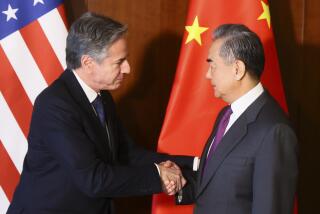The Love Match That Rocked China : French Diplomat, Chinese Artist Find Respite at Stanford
- Share via
On Sept. 9, 1981, the fifth anniversary of Mao Zedong’s death, artist Li Shuang was arrested at the gates of Peking’s diplomatic compound and sent to prison.
For the next 22 months, she sat alone in her cell. She wasn’t allowed to paint. She had no books, no company, no recreation. She passed the time thinking and painting pictures in her mind.
She was accused of hooliganism. Her real crime was to fall in love with French diplomat Emmanuel Bellefroid. To some Chinese officials, it was tantamount to treason.
The couple’s plight became an international cause celebre. Even now, almost three years after Li’s release, the two, now married, are household names in France.
A Visiting Scholar
But in the United States, the nightmare seems more remote. Bellefroid quietly works as a visiting scholar at Stanford’s Hoover Institution. Li paints, makes paper cuts and exhibits in local galleries. Few people here know about their story.
The two enjoy their temporary anonymity.
“I don’t always want to be regarded as a love object,” Li said. “I want to be known as an artist.”
Bellefroid calls his time at Stanford a transitional period--a chance to escape the celebrity of being the diplomat with the Chinese lover.
He worries that it will be difficult to return to his job at the French Foreign Ministry. The government’s help was essential in freeing Li; but Bellefroid’s fame makes another diplomatic post awkward.
He has considered teaching Chinese history or perhaps even a business post in Asia. For the moment, though, Stanford gives him a chance to think.
Beginning Anew
“Meeting Shuang and going through the Li Shuang affair has terribly disturbed my life,” he said. “I have to begin anew.”
Bellefroid’s work at Stanford concerns, in part, China since the Cultural Revolution. He doesn’t like to discuss it for fear of compromising people he knows in China.
But he said his research has helped him see his experience in China more objectively. In its attack on him and Li, China was wrestling with its xenophobia, Bellefroid said. A Frenchman marrying a Chinese woman epitomized the ancient Chinese fear of foreigners stealing the country’s “essence.”
“It’s a centuries-old dilemma for China,” Bellefroid said. “How to become part of the world after being the world. We paid for the Chinese adaptation to the world.”
For Li, the one-year stay in the United States has been a welcome relief from the many requests for interviews in France. She spends most of her time alone in the couple’s tiny Mountain View apartment, painting, paper cutting and doing embroidery. It’s become “a search for myself and how best to paint.”
She has begun to make a small name for herself internationally. Two spring exhibits of paintings and paper cuts were moderately successful. Over the next year, she’ll have exhibits in San Francisco, New York, London and Paris.
The story began in 1980, when Li and Bellefroid met at the Peking Art Gallery.
Bellefroid, then 31, was the press attache for the French Embassy in Peking. Li, 23 at the time, was a founding member of the Stars Society, a small group of dissident artists. She survived on $15 a month, painting backdrops for stage sets.
Touring the art exhibition, Bellefroid was impressed by one of Li’s woodblock prints and asked a sculptor friend to introduce them.
The exhibition was a triumph for Li and other members of the Stars Society. Previously, a display of unorthodox paintings outside the museum had been confiscated.
The two fell in love and decided to get married within a month.
“It was kind of a rash decision on our part,” Bellefroid said. “I knew it would be difficult.”
Wary of government disapproval, the couple didn’t announce their decision at first.
In June, 1981, they finally declared their marriage plans to the French Embassy and the Chinese government. In August, fearing a government reprisal against Li, they moved in together in the diplomatic compound.
A Smooth Beginning
At first, things seemed to go smoothly. They planned their wedding for the beginning of October. At the end of August, approval came through from the Chinese ministry.
But trouble brewed behind the scenes.
Bellefroid thinks the conservative wing of the Chinese Communist Party wanted to “make an example” of them to discredit the more liberal wing.
Li was suspect on two accounts: She was a painter of unauthorized subjects; and she was living with a foreigner--and a diplomat to boot.
She was arrested only weeks before the marriage ceremony. Her arrest was justified by classifying her as an “offender against the dignity of Chinese society.” She was sentenced to two years in “re-education camp,” a Chinese euphemism for prison.
Bellefroid learned about the arrest shortly after he returned from a trip to Hong Kong. He was shocked, but didn’t despair.
“I had to fight back,” he said. “It wasn’t a kind of rational hope. But I was sure I was going to win.”
Indirect Pressure
Bellefroid’s strategy was to put enormous indirect pressure on the Chinese government through the international media and the French government. The story was covered by media throughout Asia and caused a stir in France. Meanwhile, Bellefroid met with top-ranking French officials.
Events culminated in January, 1983, when the president of the French Congress met with Chinese Communist Party head Hu Yao-bang. Li finally was released in July 1983, shortly after a visit by French President Francois Mitterrand and two months before the end of her sentence.
After a six-month delay, Li jetted alone to France. She was met at the airport in Paris by Bellefroid and dozens of French journalists.
The first 12 months in France were difficult. Li found the new country strange. The two were constantly approached for interviews. Their wedding was a media event.
“I was grateful to French public opinion,” Bellefroid said. “I thought it was my duty to give the end of the story.”
Li prefers to separate her art from her traumatic experience in prison. But it’s hard to look at some of the anguished figures in her paintings without recalling her last years in China.
One untitled work, for example, is a tangled web of unhappy female faces, hands and feet painted in hues of blue, yellow and violet. The background is a bleak mountaintop, with an incongruous purple chair behind the prone figures.
To Li, a true understanding of herself is possible only if she taps her darker side.
“Life isn’t like a child who’s happy because he drinks milk,” Li said. “Looking at a rose or a beautiful woman isn’t enough. Despair is also beautiful.”
More to Read
The biggest entertainment stories
Get our big stories about Hollywood, film, television, music, arts, culture and more right in your inbox as soon as they publish.
You may occasionally receive promotional content from the Los Angeles Times.










